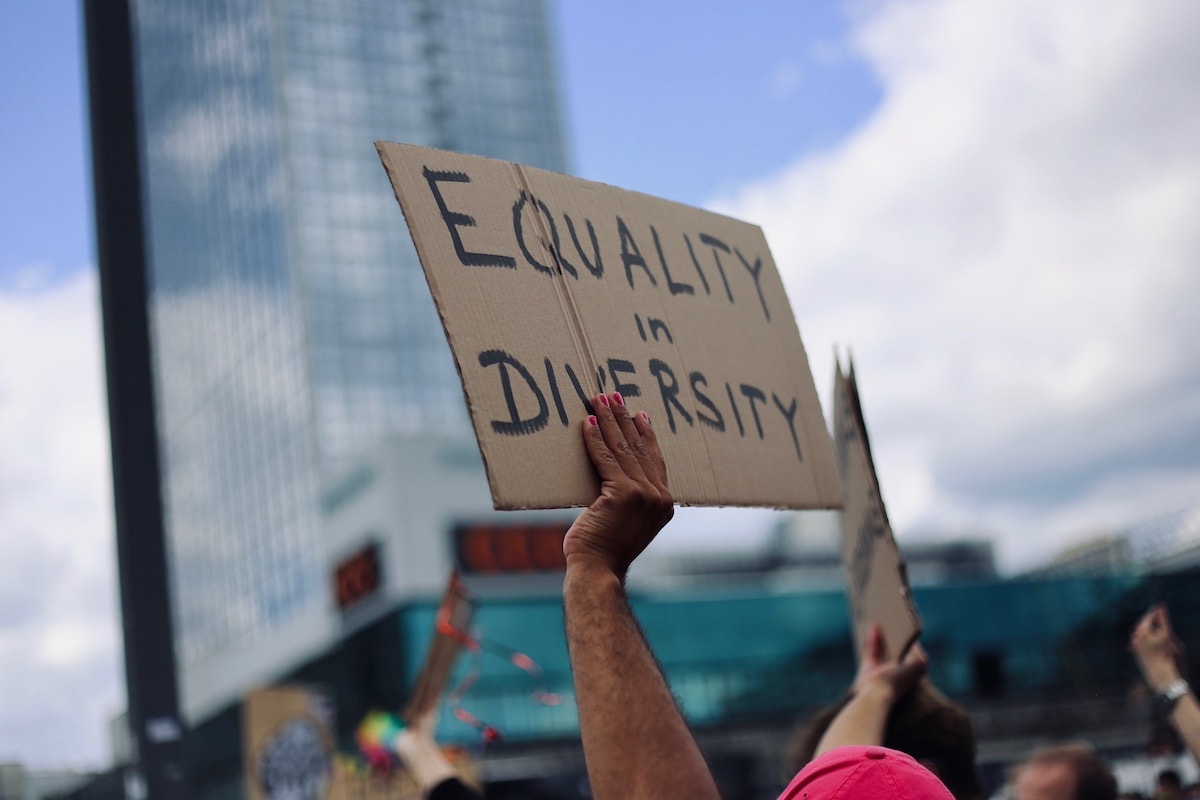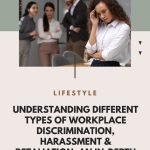In today’s modern society, where diversity and inclusion are touted as important values, it may shock many that workplace discrimination is still prevalent. Unveiling the ugly truth, we aim to expose the dark underbelly of the corporate world and shed light on the various forms of discrimination that persist in workplaces across the globe. From subtle biases to overt acts of prejudice, addressing and confronting these injustices head-on is crucial.
Workplace discrimination encompasses various unacceptable behaviors that can profoundly affect individuals and their career prospects. Whether it is race, gender, age, religion, disability, or any other characteristic, discrimination in the workplace can manifest itself in countless ways, leaving victims feeling marginalized and powerless.
By shedding light on this pressing issue, it seeks to ignite a conversation that goes beyond mere awareness and leads to tangible action toward creating inclusive and equitable workplaces for all. So, buckle up as we embark on a journey to unravel the truth behind workplace discrimination and explore the steps we can take to address and eradicate it.

Workplace Discrimination: Meaning and Definition
Workplace discrimination is any unfair treatment or unfavorable actions taken against an individual or group based on certain protected characteristics. These characteristics include race, gender, age, religion, disability, and sexual orientation.
Discrimination can occur in various ways within the workplace. It can be overt and explicit, such as denying someone a promotion based on their race or making derogatory comments about someone’s gender. However, this can also be subtle and covert, taking the form of unconscious biases or microaggressions that perpetuate inequality.
It is important to note that this type of treatment is morally wrong and illegal in many countries. Laws such as the Civil Rights Act of 1964 in the United States and similar legislation in other countries aim to protect individuals and promote equal opportunities for all.
Harassment and Discrimination: A Correlation
Workplace harassment and discrimination are two interconnected issues that continue to plague organizations worldwide. Workplaces that witness discrimination cases often experience a higher rate of harassment incidents. Discrimination can manifest in various forms, such as unequal treatment, biased hiring practices, and wage disparities. These disparities create an environment where harassment thrives as marginalized individuals become more vulnerable targets.
A key aspect to understanding this correlation lies in the power dynamics within organizations. When individuals are targeted based on their race, gender, religion, or other protected characteristics, they often find themselves in positions where they have little recourse to address the harassment they face. This power imbalance exacerbates the discrimination and creates an environment of fear and intimidation.
Organizations must take proactive steps to address workplace discrimination and combat harassment effectively. Implementing clear policies that promote diversity and inclusion, providing training on recognizing and addressing discriminatory behavior, and establishing confidential reporting mechanisms are crucial steps in creating a safe and equitable work environment.
What are the Types of Workplace Discrimination?
Workplace discrimination takes many forms, each with its unique challenges and consequences. Understanding these different types is crucial to addressing and combating them effectively.
Racial discrimination
This occurs when an individual is mistreated or disadvantaged based on race or ethnicity. It can manifest in various ways, such as unequal pay, denial of promotions, or exclusion from specific opportunities.
Gender discrimination
This is another prevalent form that occurs when individuals are treated differently based on their gender, often resulting in unequal treatment and opportunities. This can include pay disparities or the denial of promotions based on gender stereotypes.
Age discrimination
Older employees may face prejudice and unfair treatment due to their age, leading to missed opportunities for career advancement or even termination based on age-related stereotypes. They may face challenges in being overlooked for promotions and encounter barriers to training and development opportunities. Overcoming age discrimination requires recognizing the value of experience and expertise across all age groups.
Religious discrimination
Involves mistreating individuals because of their religious beliefs or practices. This can include denying religious accommodations, derogatory comments about someone’s faith, or excluding individuals from certain activities based on their religion.
LGBTQ+ Discrimination:
LGBTQ+ individuals often face discrimination based on their sexual orientation or gender identity. This can come in offensive remarks, exclusion from social activities, or unfair treatment in hiring and promotions.
Pregnancy and Disability Discrimination
Pregnancy discrimination occurs when an employer treats a woman unfavorably due to her pregnancy, while disability discrimination refers to treating someone less favorably because of their disability.
Pregnant women may face discrimination when denied promotions, forced to take unpaid leave, or subjected to negative comments about their condition. Similarly, individuals with disabilities may experience discrimination when they are denied reasonable accommodation or face harassment at work. This can also involve refusing to hire qualified candidates with disabilities or subjecting employees to a hostile work environment because of their disability.
Race Discrimination, Harassment and Discrimination Against Minority Women
Race discrimination, harassment, and discrimination against minority women are critical issues that persist in many workplaces. These issues not only hinder the growth and progress of individuals but also undermine the overall productivity and harmony of the workplace. Minority women often face intersecting discrimination as they may encounter biases based on both their gender and race.

Exploring Types of Harassment at Work
Workplace discrimination is a pervasive issue that takes various forms, each with its damaging consequences. Understanding the different types of harassment that can occur in the workplace is crucial to address and eradicate this problem.
Sexual Harassment: This involves unwelcome advances, requests for sexual favors, comments, or behavior of a sexual nature. It can range from inappropriate comments or gestures to unwelcome advances or sexual assault. This type of harassment creates an uncomfortable and hostile work environment, often causing emotional and psychological distress for the victims.
Racial Discrimination: This type of harassment occurs when individuals are treated differently or unfairly because of their race or ethnicity. It can manifest in various ways, such as racial slurs, offensive jokes, or exclusion from specific opportunities or benefits.
Ageism: Targets individuals based on their age, particularly older employees. It can involve denying promotions, training, or benefits. This form of harassment disregards the skills and experience that older workers bring to the table.
Disability Discrimination: This is against individuals with disabilities and can manifest in various ways, such as denying accommodations, making derogatory comments, or excluding them from certain tasks or projects.
Religious Discrimination: It can involve mocking or belittling someone’s faith, denying religious accommodations, or creating a hostile environment for individuals with different religious beliefs.
Verbal Harassment: involves offensive or derogatory remarks directed toward an individual or a group of people. This can include racial slurs, sexist comments, or homophobic remarks. Verbal harassment not only damages an individual’s self-esteem but also creates a toxic work environment.
Physical Harassment: includes unwanted physical contact, assault, or threats of violence. This type of harassment can leave victims feeling unsafe and violated in their workplace.
Emotional abuse is equally damaging, often manifesting as constant criticism, isolation, or intimidation. This type of harassment can have severe psychological effects on the victim, leading to decreased productivity and overall job satisfaction.
Bullying: Workplace bullying is characterized by repeated mistreatment, such as insults, threats, humiliation, or sabotage. It can psychologically impact an employee’s mental well-being.
Cyberbullying involves the use of electronic communication to harass or intimidate co-workers, often through online platforms or social media.
Verbal Abuse: Is the use of offensive language, insults, or derogatory remarks towards an individual. This form of harassment can be highly damaging emotionally and can erode self-esteem. Retaliation occurs when an employee faces adverse consequences for reporting harassment or participating in an investigation.
Systemic Harassment occurs when discriminatory practices or policies are embedded within an organization. This can involve unfair hiring practices, pay discrepancies, or limited opportunities for advancement based on factors such as race, gender, or age. Systemic harassment perpetuates inequality and limits individuals’ ability to thrive in their professional lives.

The Act of Discrimination in the Workplace: Identification
Identifying workplace discrimination can be challenging as it often occurs subtly or behind closed doors. Some common acts of discrimination include:
– Unequal pay: Paying employees different wages based on their protected characteristics such as gender or race.
– Denial of promotions: Refusing to promote qualified individuals based on their protected characteristics.
– Harassment: Creating a hostile work environment through unwelcome behavior or comments about an individual’s protected characteristics.
– Segregation: Separating employees based on their protected characteristics, such as assigning certain tasks only to specific racial or ethnic groups.
– Retaliation: Taking adverse actions against employees who report instances of discrimination or participate in investigations regarding discrimination complaints.
If you suspect discrimination in your workplace, it is essential to gather evidence and consult with legal professionals or human resources representatives who can guide you through the appropriate steps to address the issue.
Consequences of Discrimination in Your Workplace
The consequences can be far-reaching and detrimental for both individuals and organizations. Some common consequences include:
- Decreased employee morale: It creates a toxic work environment that erodes employee trust, collaboration, and overall job satisfaction.
- Increased turnover: Employees may choose to leave their jobs due to the negative impact on their well-being and career prospects.
- Legal repercussions: Organizations that engage in these practices may face legal action, resulting in financial penalties and damage to their reputation.
- Lost productivity: Discrimination hinders productivity as employees who feel marginalized or undervalued are less likely to perform at their best.
Addressing Harassment and Discrimination Issues

Organizations need to create a safe and inclusive environment for all employees to combat workplace discrimination. This can be achieved through the implementation of policies and procedures. These policies should clearly define what constitutes discrimination and harassment and the consequences for those who engage in such behavior.
Training programs should also be conducted to educate employees about their rights and responsibilities in the workplace. By promoting awareness and understanding, organizations can empower their workforce to recognize and report discrimination when it occurs.
Reporting and filing complaints is a crucial step in acting against workplace discrimination. It empowers employees to challenge unjust practices and demand justice. When faced with workplace discrimination, gathering evidence to support your claim is important. Document incidents, collect witness statements, and preserve any relevant communication. This evidence will strengthen your case when reporting the discrimination.
Before reporting, familiarize yourself with your company’s policies and procedures regarding workplace discrimination. This will ensure you follow the correct channels and understand the steps involved. Typically, you must submit a formal complaint to your HR department or a designated authority within your organization.
When you are ready to file a complaint, describe the behavior clearly and concisely. Include dates, times, locations, and the people involved. Provide any evidence you have gathered to support your claim. It is essential to remain professional and objective throughout the process.
Once the complaint is filed, your employer is legally obligated to investigate and address the issue. They may conduct interviews, review documents, and act appropriately against the offender. Cooperating with the investigation and providing any additional information, if requested, is very important. By reporting and filing complaints, you stand against injustice and pave the way for a fair and inclusive work environment.
Understanding the Role of a Workplace Discrimination Policy
Workplace discrimination remains an unfortunate reality for many employees in today’s corporate world. Discrimination can occur in various forms, such as race, gender, age, religion, or disability. Companies need to implement a robust policy to combat this issue and create a fair and inclusive environment.
A workplace discrimination policy is a guideline for employers and employees, outlining the acceptable behavior and consequences of discriminatory actions. This policy is a deterrent, clarifying that discriminatory behavior will not be tolerated. It also provides a framework for handling complaints and resolving conflicts.
One of the key roles of such policy is to promote a diverse and inclusive workforce. By setting clear expectations for equal treatment, companies encourage employees from all backgrounds to contribute their unique perspectives and talents. This fosters innovation and creativity, leading to better business outcomes.
A discrimination policy helps protect both employees and employers from legal consequences. It ensures compliance with anti-discrimination laws and regulations, reducing the risk of costly lawsuits and damage to the company’s reputation. By demonstrating a commitment to equality, companies can attract and retain top talent who value fairness and inclusivity.

How to Report Workplace Discrimination Effectively
Reporting such incidents is vital to creating a safe and inclusive work environment. Here are some key tips on how to report workplace discrimination effectively.
1. Gather evidence: You need documentation supporting your claim before reporting any incident. This can include emails, messages, and witness testimonies.
2. Know your rights: Familiarize yourself with your company’s policies and procedures regarding discrimination. Understand the reporting process and the steps involved.
3. Choose the right channel: Identify the appropriate person or department to report the discrimination. This could be your supervisor, human resources, or a designated individual responsible for handling such complaints.
4. Provide a clear and concise account: When reporting, be specific about the incident, including dates, times, locations, and individuals involved. Provide as much detail as possible to help the investigator understand the situation better.
5. Maintain confidentiality: If you prefer to remain anonymous, inform the person handling your complaint. They should respect your privacy and ensure confidentiality throughout the investigation.
6. Follow up: After reporting, follow up with the designated individual or department to check on the progress of the investigation. It is essential to stay informed and involved in the process.
Reporting workplace discrimination is about seeking justice for yourself and creating a safer and more inclusive work environment for everyone. Your courage to report can inspire others to come forward and initiate positive change.
Understanding Discrimination Laws: EEOC and Civil Rights Act of 1964
To address this problem, it is essential to have a comprehensive understanding of federal and state laws that protect employees against workplace discrimination. The Equal Employment Opportunity Commission and the Civil Rights Act of 1964 are two critical components of these laws.
The EEOC is the federal agency responsible for enforcing laws against workplace discrimination. Its primary role is to investigate complaints of discrimination and ensure that employers comply with the laws. They cover various protected characteristics, including race, color, religion, sex, national origin, age, disability, and genetic information. Employees must be aware of their rights and the process of filing a complaint with the EEOC if they believe they have been discriminated against.
The Civil Rights Act of 1964 is one of the most significant pieces of legislation in the history of employment discrimination. Title VII of the Civil Rights Act prohibits discrimination against race, color, religion, sex, and national origin. It applies to employers with 15 or more employees, including federal, state, and local governments. The Act also established the EEOC to enforce its provisions.
Understanding state and federal law is essential for both employers and employees. Employers must maintain a fair and inclusive work environment, and employees should be aware of their rights and protections under the law.

EEOC’s Role in Addressing Workplace Discrimination
The Equal Employment Opportunity Commission plays a crucial role in addressing workplace discrimination. With a mission to promote equality and eradicate workplace bias, they act as a watchdog for employees’ rights. Enforcing federal laws, investigating complaints, and litigating cases ensure that workplaces are free from discrimination, color, race, religion, sex, national origin, disability, or age.
Through education and outreach programs, they raise awareness about workplace discrimination and guide both employers and employees. They also offer training sessions and resources to equip individuals with the knowledge and tools necessary to recognize and report these practices.
When an employee believes they have been subjected to discrimination, the EEOC steps in to investigate the claim. They gather evidence, interview witnesses, and evaluate the complaint’s merit. If they find evidence of discrimination, they will attempt to settle with the parties involved. In cases where a settlement cannot be achieved, they may file a lawsuit on behalf of the employee.
Not only do they address individual complaints, but they also take a proactive approach to combat systemic discrimination. By conducting audits and reviews of workplace policies, they identify patterns of discrimination and implement necessary changes to prevent future occurrences.
They hold employers accountable and advocate for employee rights, helping to ensure that workplace discrimination is exposed and addressed effectively.

How Federal Law Protects from Employment Discrimination
Federal law has implemented measures to protect employees from unjust treatment. These laws provide a framework for addressing and rectifying instances of employment discrimination. To enforce these laws, the Equal Employment Opportunity Commission serves as a regulatory body that investigates workplace discrimination complaints and takes appropriate action against violators.
One key legislative instrument is Title VII of the Civil Rights Act of 1964, which prohibits discrimination of color, race, religion, sex, or national origin.
The Americans with Disabilities Act (ADA) ensures protection for individuals with disabilities in the workplace. It prohibits discrimination against qualified individuals and requires employers to provide reasonable accommodations to enable employees to perform their duties.
Age discrimination is also addressed through the Age Discrimination in Employment Act (ADEA), which safeguards individuals aged 40 and above from discriminatory practices related to hiring, firing, promotions, and layoffs.
The Equal Pay Act (EPA) mandates equal pay for equal work, regardless of gender. This legislation aims to eliminate the gender pay gap and ensure fair compensation for all employees.
Federal laws play a crucial role in safeguarding employees. By offering protection against various forms of bias, they ensure that all individuals have equal opportunities and fair treatment in the workplace.

Filing a Discrimination Complaint with EEOC: A Step-by-Step Guide
Filing a discrimination complaint with the EEOC is important in addressing workplace discrimination. By following a step-by-step guide, individuals can ensure that their concerns are appropriately documented and investigated.
1. Gather evidence: Before filing, it is crucial to have evidence to support your claims of workplace discrimination. This may include emails, witness statements, or any other relevant documentation.
2. Contact the EEOC: Reach out to the office nearest to you to initiate the complaint process. You can find their contact information on their official website.
3. Provide essential information: When contacting the EEOC, be prepared to provide details about the discrimination you experienced, such as the dates, times, and individuals involved. They will guide you through the necessary forms and paperwork.
4. File a Charge of Discrimination: The EEOC will ask you to complete a Charge of Discrimination form. This form will require you to provide a detailed account of the incidents and the harm caused.
5. Investigation: They will investigate your claims once the charge is filed. This may involve interviews, gathering additional evidence, and consulting with relevant parties.
6. Mediation: In some cases, they may offer mediation as an alternative to a formal investigation. Mediation allows both parties to resolve with the assistance of a neutral mediator.
7. Determination: The EEOC will decide once the investigation or mediation is complete. If they find reasonable cause to believe discrimination occurred, they will attempt to resolve the matter through settlement or legal action.
By following this step-by-step guide, individuals can navigate the process of filing a discrimination complaint with the EEOC. It is important to remember that seeking legal advice or representation may also be beneficial during this process to ensure your rights are protected.
How to Deal with Retaliation After Reporting Discrimination
Retaliation after reporting discrimination is a serious issue that many individuals face in the workplace. It can be challenging and distressing to deal with, but some steps can be taken to address and overcome this form of workplace injustice.
Keep a detailed record of the retaliatory acts, including dates, times, and descriptions. This documentation can serve as evidence if legal action becomes necessary.
Next, reach out for support. Inform trusted colleagues, friends, or family members about the situation. Their emotional support can provide comfort during this difficult time. Also, consult with an attorney or join support groups specializing in workplace discrimination cases.
Maintaining professionalism is essential, and it is important not to stoop to the level of the individuals retaliating against you. Focus on your work and continue to perform to the best of your abilities. This will demonstrate your dedication and commitment to your job.
Reporting the retaliation to the appropriate channels is crucial. If your company has a human resources department or an ethics hotline, utilize these resources to report the incidents. Be sure to provide all necessary documentation to support your claims. Lastly, consider seeking legal recourse. Consult with an attorney who specializes in employment law to discuss your options. They can guide you through the legal process and help you seek justice.
Individuals can address and overcome this injustice by documenting incidents, seeking support, maintaining professionalism, reporting retaliation, and seeking legal recourse.

Addressing workplace discrimination requires a collective effort from employers and employees. By promoting awareness, fostering a culture of respect, and supporting victims, we can work towards eliminating harassment and creating a more equitable and inclusive working environment. By promoting inclusivity, diversity, and equality, we can build workplaces that celebrate differences and provide equal opportunities for all individuals, regardless of their sexual orientation or religious beliefs.
Frequently Asked Questions
Q: What are the different types of discrimination that might occur in the workplace?
A: There are multiple ways discrimination can take place. Among these are age, race, national origin, gender identity, pregnancy, and genetic information. It’s also illegal for an employer to discriminate against employees based on disabilities, according to the Americans with Disabilities Act.
Q: Can you explain pregnancy discrimination in the workplace?
A: Pregnancy discrimination refers to the unjust treatment of women because of pregnancy, childbirth, or medical conditions related to either. The Pregnancy Discrimination Act, enforced by the U.S. EEOC, prohibits this type of discrimination.
Q: How does the Equal Employment Opportunity Commission play a role in preventing discrimination based on race?
A: They enforce federal laws prohibiting discrimination based on an individual’s race. When a complaint is filed with the EEOC, they investigate the allegations and may file a lawsuit to protect the rights of individuals and the interests of the public.
Q: How can a job applicant recognize discrimination during the application process?
A: Recognizing discrimination can sometimes be complex. An applicant might identify discrimination if they experience unfavorable treatment, specifically with regard to age, race, sexual orientation, gender identity, or nationality. An employment attorney can help individuals understand if they have been subjected to unlawful discrimination.
Q: What does ‘discrimination vs sexual harassment’ mean? And can it occur in U.S. workplaces?
A: Discrimination and sexual harassment are two different types of workplace issues. Discrimination refers to unfair treatment based on one’s protected attributes, while sexual harassment refers to unwelcome sexual advances or conduct. Both are illegal under U.S. law. Title VII of the Civil Rights Act regulates these actions.
Q: What kind of discrimination charges can I file with the EEOC?
A: A person can file a complaint with them for various types of discrimination, like race, gender identity, pregnancy, sexual orientation, or national origin. They also handle age discrimination complaints under the Age Discrimination in Employment Act.
Q: What steps can an employer take to prevent discrimination in the workplace?
A: Training programs can be installed to educate employees about the prevalence of discrimination and how to avoid it. Employers should also implement anti-discrimination policies, have a process for filing and addressing complaints, and ensure fair and equal treatment at work.
Q: Is it necessary to provide employees equal pay for equal work?
A: Yes, under the Equal Pay Act, employers must provide equal pay for equal work regardless of the employee’s gender. This Act protects against wage discrimination based on sex.
Q: How can an accommodation be considered a discriminatory act?
A: An accommodation may be considered discriminatory if it puts certain employees at a disadvantage based on protected characteristics. For instance, if a workplace accommodation based on age negatively affects older employees, it could be considered discriminatory under the Age Discrimination in Employment Act.
Q: What should I do if I have been the victim of workplace discrimination?
A: If you believe you have been discriminated against, you should file a complaint with the EEOC. The complaint process may be complex, so an attorney can help guide you. If the EEOC finds the complaint legitimate, appropriate actions will be taken to rectify the situation.
You might also be interested in…
If you’re looking for more information on workplace discrimination? Check out Women’s Rights VS The Global Pandemic
CONNECT WITH DAILY MOM
💖 NEWSLETTER: DAILY READS IN YOUR INBOX 💖
Sign up to receive our picks for the best things to do, see and buy so you can relax and focus on more important tasks! Let us help you be the best version of yourself you can be!
BE SOCIAL WITH US
📌 LOVE IT? PIN IT!📌












































